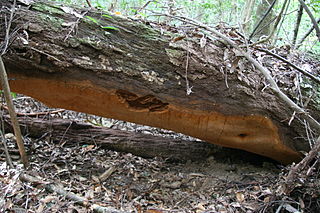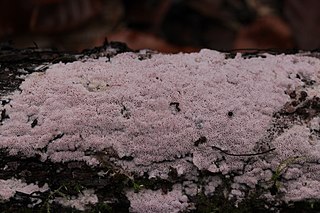Related Research Articles

Ceriporia is a widely distributed genus of crust fungi.

Phellinus ellipsoideus is a species of polypore fungus in the family Hymenochaetaceae, a specimen of which produced the largest fungal fruit body ever recorded. Found in China, the fruit bodies produced by the species are brown, woody basidiocarps that grow on dead wood, where the fungus feeds as a saprotroph. The basidiocarps are perennial, allowing them to grow very large under favourable circumstances. They are resupinate, measuring 30 centimetres (12 in) or more in length, though typically extending less than a centimetre from the surface of the wood. P. ellipsoideus produces distinct ellipsoidal spores, after which it is named, and unusual setae. These two features allow it to be readily differentiated microscopically from other, similar species. Chemical compounds isolated from the species include several steroidal compounds. These may have pharmacological applications, but further research is needed.
Perenniporia nanlingensis is a poroid fungus first isolated from Guangdong Province, China. It has crust-like fruit bodies with a pinkish pore surface when in dry condition. Microscopically, it has a trimitic hyphal system, a slightly dextrinoid and binding hyphae. Its basidiospores are ellipsoid, truncate, and measure 9.0–9.8 by 5.0–5.9 μm.
Haploporus cylindrosporus is a species of poroid crust fungus in the family Polyporaceae. Found in China, it causes a white rot in decomposing angiosperm wood.
Skeletocutis luteolus is a species of poroid crust fungus in the family Polyporaceae. It is found in southern and eastern China, where it causes white rot.

Nigroporus vinosus is a species of poroid fungus in the family Steccherinaceae, and the type species of the genus Nigroporus. Its fruit bodies have brownish caps with tinges of purple or red. The cap underside has a pore surface the same colour as the cap, and minute pores. Nigroporus vinosus has a pantropical distribution. It has been recorded from Africa, North America, Central America, South America, Asia, and Oceania. It is a wood-decay fungus that causes a white rot.
Fibroporia albicans is a species of poroid crust fungus in the family Fomitopsidaceae. It causes a brown rot. The fungus was described in 2015 as a species new to science, based on collections made in Jiangxi and Xizang Provinces, China. It is one of five Fibroporia species recorded in China.
Dichomitus hubeiensis is a crust fungus that was described as a new species in 2013. The fungus is characterized by the cream to straw-yellow pore surface and large pores numbering 1–2 per millimetre. Microscopic features include both inamyloid and indextrinoid skeletal hyphae, the presence of cystidioles and dendrohyphidia in the hymenium, and roughly ellipsoid spores that measure 10–14 by 5.6–7.0 µm. The specific epithet refers to the type locality in Hubei, central China.
Skeletocutis inflata is a species of poroid fungus in the family Polyporaceae. Found in Guangdong, China, it was described as a new species in 2013 by mycologist Bao-Kai Cui. The fungus is characterized by having fruit bodies with caps, and small pores numbering 8–10 per millimetre. Microscopically, it features inflated skeletal hyphae that partially dissolve in a solution of potassium hydroxide (KOH). The skeletal hyphae in the trama are parallel along the tubes.
Megasporoporia minor is a species of crust fungus in the family Polyporaceae. Found in China, it was described as a new species in 2013 by mycologists Bao-Kai Cui and Hai-Jiao Li. The type was collected was made in Daweishan Forest Park, Yunnan, where it was found growing on a fallen angiosperm branch. It is distinguished from other species of Megasporoporia by its relatively small pores and small spores ; it is these features for which the fungus is named.
Megasporoporia bannaensis is a species of white rot crust fungus in the family Polyporaceae. Found in China, it was described as a new species in 2013 by mycologists Bao-Kai Cui and Hai-Jiao Li. The type was collected in Sanchahe Nature Reserve, Yunnan, where it was found growing on a fallen angiosperm branch. It is characterized by its relatively large pores, the unbranched skeletal hyphae, and long, thin hyphal plugs in the hymenium. Its spores measure 10–14 by 3.9–4.6 μm. The specific epithet bannaensis refers to the type locality (Xishuang-Banna).
Fragiliporia is the sole genus in the fungus family Fragiliporiaceae. It contains the poroid crust fungus Fragiliporia fragilis, described as new to science by Chinese mycologists in 2014. The type specimen of this fungus was discovered growing on a rotting stump of alder in the Gaoligongshan National Nature Reserve in Yunnan. The specific epithet fragilis refers to the brittle fruit bodies of the fungus. Molecular phylogenetics shows that the fungus is in an isolated position in the Polyporales, distinct from the six previously identified clades in this order. In a later study (2017), Fragiliporia was recovered in a phylogenetically isolated position as sister to Candelabrochaete africana.
Buglossoporus eucalypticola is a species of poroid fungus in the family Fomitopsidaceae. It was described as a new species in 2016 by mycologists Mei-Ling Han, Bao-Kai Cui, and Yu-Cheng Dai. The type specimen was collected in the Danzhou Tropical Botanical Garden, in Danzhou, China. It was growing on a dead Eucalyptus tree. The fruit body has a fan-shaped or semicircular cap that projects up to 10 cm (3.9 in), 6.5 cm (2.6 in) wide, and 7 mm (0.3 in) thick at its base. The surface colour when fresh is peach to brownish orange, but when dry becomes clay-pink to cinnamon. The pore surface on the cap underside is initially white before becoming pinkish buff or clay-buff to dark brown. B. eucalypticola causes a brown rot in its host.
Fomitopsis subfeei is a species of polypore fungus in the family Fomitopsidaceae. Found in southern China, it was reported as new to science in 2014 by mycologists Mei-Ling Han and Bao-Kai Cui. Characteristics of the fungus include perennial, effused-reflexed to pileate fruit bodies, a concentrically grooved cap surface, and a pinkish-brown to vinaceous-brown pore surface on the cap underside. Microscopic characters include spindle-shaped cystidioles, and small, oblong-ellipsoid spores measuring 4–5 by 1.9–2.5 μm. The fungus causes a brown rot on gymnosperms.
Haploporus septatus is a species of poroid crust fungus in the family Polyporaceae. Found in China, it causes a white rot in decomposing angiosperm wood.
Truncospora macrospora is a species of poroid fungus in the family Polyporaceae. It was described as new to science in 2013 by Chinese mycologists Bao-Kai Cui and Chang-Lin Zhao. The fungus, found in southwest China, is distinguished by its annual growth habit, and the distinct dark brownish crust on its caps. The semicircular caps measure about 1.5–3 cm (0.6–1.2 in) long, 2.5–3.5 cm (1.0–1.4 in) wide, and 1–4 cm (0.4–1.6 in) thick. Microscopic characteristics include its relatively large spores, measuring 16.5–19.5 by 8.0–9.5 μm, which have a strongly dextrinoid reaction. The type was collected in the Gaoligong Mountains at an altitude of 2,400 metres (7,900 ft), where it was found growing on a fallen angiosperm branch.
Datroniella tropica is a species of crust fungus in the family Polyporaceae. Found in southwestern China, it was described as a new species in 2014 by mycologists Bao-Kai Cui, Hai J. Lee, and Yu-Cheng Dai, who placed it in the new genus Datroniella. The type collection was made in Tongbiguan Nature Reserve, where the fungus was found growing on a fallen angiosperm branch. The specific epithet tropica refers to its distribution in tropical China.

Ceriporia excelsa is a species of crust fungus in the family Irpicaceae. It is found in Europe and North America, where it typically grows on dead hardwood. It has also been recorded from China.
Perenniporia meridionalis is a poroid crust fungus in the family Polyporaceae. It was described as a new species by Cony Decock and Joost Stalpers in 2006. The holotype specimen was collected in the Province of Nuoro in Italy, where it was found growing on dead wood of Quercus ilex. Distinguishing characteristics of this fungus include its relatively large pores, the hyaline vegetative hyphae that are yellowish to slightly dextrinoid in Melzer's reagent, and large spores measuring 6.0–7.7 by 4.5–6.2 µm. P. meridionalis occurs in central and southern Europe, where it is found in warmer forested areas, usually on dead oak wood. It has also been reported to occur in North America.
Ungulidaedalea is a fungal genus in the family Fomitopsidaceae. The genus was circumscribed by Chinese mycologists in 2016 to contain the single species Ungulidaedalea fragilis, a fungus that was described as new in 2014 with the name Fomitopsis fragilis. The holotype of this fungus was collected in Jianfengling Nature Reserve, in Ledong County (Hainan). The generic name Ungulidaedalea refers to the resemblance between this species and Daedalea, and also to the hoof-shaped (ungulate) form of the fruit body. Ungulidaedalea fragilis has rather fragile fruit bodies with a dark brown crust and large angular pores on the cap underside. Microscopic characteristics include its densely septated skeletal hyphae, and oblong-ellipsoid spores that measure 4–5.2 by 2.2–2.8 μm.
References
- 1 2 Jia, Bi-Si; Cui, Bao-Kai (2012). "Two new species of Ceriporia (Basidiomycota, Polyporales) with a key to the accepted species in China". Mycotaxon. 121: 305–312. doi: 10.5248/121.305 .